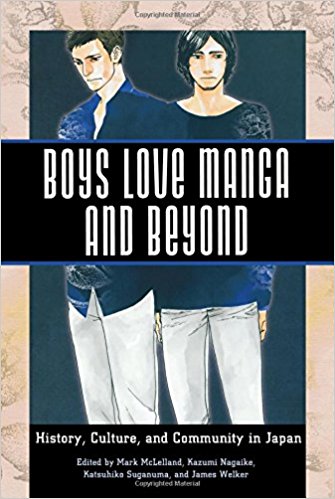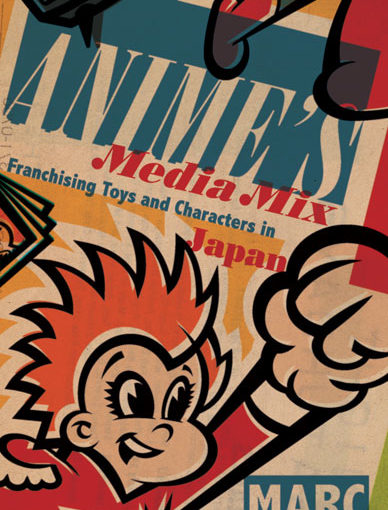Review of Boys Love Manga and Beyond: History, Culture, and Community in Japan, Edited by Mark McLelland, Kazumi Nagaike, Katsuhiko Suganuma, and James Welker (University Press of Mississippi, 2015).
By Casey Lee
Boys Love (BL) is a by-women-for-women form of male/male homoerotic media originating in Japan. For much of its more than forty-year history, it has been circulated, consumed, re-appropriated and discussed in various locales outside of Japan. Existing English-language scholarship on BL has tended to focus on its global dissemination as a sub-formation of Japanese animation, comics, and gaming culture; a Japanese-influenced subculture of media fandom; or a subgenre of fiction—predominantly fan, internet, women’s, and/or romance. The volume in review is a long-awaited intervention that contributes a historical and critical understanding of BL in Japan. The twelve essays in this anthology add much-needed specificity and depth to BL not just as a historical sphere of fictional production, but as (as the “beyond” in the title suggests) a site where media industries, consumer/fan practice, and sociopolitical discourses interact.
Boys Love Manga and Beyond functions as a BL studies reader and field guide. It connects western readers to discourse and materials on the topic not necessarily available in English while showcasing the methodological and disciplinary breadth of BL studies. The essays collected here make use of close reading, ethnography, field interviews, and archival research from the perspectives of history, sociology, media studies, gender and queer studies, manga studies, and literature. These essays propose new directions for this growing global subfield of popular culture, gender studies, and media fandom.
Following a thorough introduction, the first five chapters attend to the history and historiography of BL. Opening the collection is Barbara Hartley’s essay on genealogy, which constructs a prehistory of BL readership through analysis of the cross-gender appeal of erotic “excess” in Takabatake Kashô’s illustrations of beautiful young men in prewar shônen magazines. Hartley productively connects the appropriation of beautiful boy images by the female gaze in the 1920s-30s to the intensified policing of female sexuality under Japan’s emergence as a modern nation-state. James Welker follows with an overview of BL’s relationship with various categories of postwar media for girls and young women, with notable focus on stylistic qualities, themes, and conventions drawn from highbrow literature and western culture. Whereas BL has fascinated worldwide as a cultural export from Japan, both of these essays shed light on some of its historical ties to Japan’s interactions with the West.
If Welker’s essay historicizes the many categories and terms (i.e. shônen’ai, yaoi, JUNE, and tanbi) subsumed under “BL,” chapters by Kazuko Suzuki and Fujimoto Yukari attend to their differences by considering their usage in social and critical realms. Drawing on interviews with professional BL writers, Suzuki offers insights into how distinctions between these terms, based on industry concerns with narrative convention and distribution practice, demarcate boundaries for artists that may help determine their creative direction and publishing venue. Fujimoto focuses on how the periodic specificity of these categories impact feminist-critical writing on the topic. Her essay is an exciting reflection on how her own influential writings on gender-bending and cross-dressing in women’s media twenty years ago might or might not bear on criticism of recent BL. Together, these first four essays define BL as a material object situated within a complex matrix of visual and narrative elements, gender politics, print culture, and industry practice.
Kazumi Nagaike and Tomoko Aoyama’s literature review of BL studies serves as an apt interlude that considers the major themes of BL criticism since its emergence as a viable field of academic inquiry in the 90s. There is notable focus in their essay on BL’s at times troubled relationship with LGBT and queer identity politics. Their review also situates essays in the collection within the field, preparing readers for the mid-volume shift towards understanding BL as a cultural practice that engages sociopolitical controversy and the ethics of creating/consuming media.
Whereas earlier understandings of BL readership exemplified by the work of critics such as Nakajima Azusa, Fujimoto Yukari, and Midori Matsui have tended to construct female fan pathologies from close readings of BL media, Rio Otomo’s and Patrick Galbraith’s essays both center the operations of readers’ engagements with BL as fantasy. Otomo’s personal and provocative essay considers the political potential of BL by juxtaposing BL reading practices with the confessional writings of Yukio Mishima. In contrast to the modernist male obsession with subjectivity and self-possession, she discovers in her own reading of BL a more dispersive form of identification that validates the interpersonal—a “utopia” forged out of conspiratorial relations between reader-text, text-text, and reader-reader. Galbraith provides a fascinating ethnography based on a year spent observing conversations between three yaoi fangirls. His essay likewise focuses on the transformative aspects of the interpersonal, showing “how yaoi fans use their imagination to interact differently with media, one another, and the world around them” (154). Both essays are stimulating models for interpreting BL outside of a modernist critical framework.
Essays by Jeffry T. Hester and Nagaike also zone in on the question of BL readership by looking at discourses of fandom. Hester looks at BL’s female fans, known as fujoshi (“rotten girls and women”). He traces the genealogy of fujoshi as a term popularized in the 2000s and considers some of the ways major media representations of them emphasize not the queer and subversive potential so much scholarship assigns to BL fandom, but, instead, the compatibility of BL fandom with heteronormative and capitalist lifestyles. Nagaike focuses on male fans of BL, fudanshi (“rotten boys and men”). Focusing specifically on heterosexual fudanshi, she argues that gender-ambiguity in BL offers an escape from the oppressiveness of hetero-patriarchal norms, a point that echoes much of BL criticism’s take on female readership since the 90s. While it is unclear why the study excludes analysis of gay and queer male readers of BL, it nonetheless opens up inquiry into a fandom of BL that remains little studied.
Ishida Hitoshi’s chapter reflects on developments in BL criticism since yaoi ronsô—a discursive clash in the 90s wherein some gay men charged BL with misrepresentation and misappropriation of gay realities. This controversy is an important part of BL discourse; however, Ishida’s argument is rather forced. In surveying BL criticism since the 90s, he claims that any “positive evaluation of yaoi/BL” must necessarily insist that “the men appearing in yaoi/BL have nothing to do with men in reality” or else be tantamount to a guilty admission of “representational appropriation” (119). Surely it is possible to critique homophobic and appropriative operations in BL without formulating an indictment of women centering themselves in understandings of a form of expression they created? Also, is it reasonable to assume gay experiences to be the sole domain of men? Or that, especially given the known diverse orientations of BL readers today, the discriminatory experiences of LGBT populations and BL readers can never overlap or resonate with one another?
Mark McLelland’s essay on “the future of BL” addresses some of this overlap when he describes the targeting of BL in recent controversies surrounding the regulation of media content in Japan. This growing censure reflects “general anxiety about the threat that ‘gender-free’ education and social inclusion policies represent to ‘traditional’ gender roles, male authority, and particularly young women’s reproductive choices” (263). As sexuality and gender continue to be normalized and policed in the name of social/state interests, BL discourse might be a site for considering how misogyny and homophobia intersect.
Tomoko Aoyama’s study of Yoshinaga Fumi’s manga may also demonstrate how the struggles of gay men and women can align when the humanity of both are thoughtfully and respectfully engaged. Considering the common theme of cooking in works serialized in magazines oriented towards distinct markets, Aoyama relates Yoshinaga’s widely celebrated status to her ability to adapt “BL flavor” to the tastes of “a diverse range of textual consumers and connoisseurs” (234). In Yoshinaga’s work, diversity—whether of social position, gender, or sexual orientation—is a humanizing force that acknowledges the magic of cooking as a quotidian practice of domestic and professional life, as opposed to the masculinist mythology of the worldly, itinerant “cooking man.” The “BL flavor” highlighted in this essay include storytelling finesse, convincing portrayals of characters/character relationships, and a self-aware, accessible sense of humor.
Boys Love Manga and Beyond covers an impressive range of topics and, as a semi-collective project that is both highly cross-referential and passionately engaged, highlights the positive resonances between fannish and academic practices. This open and rigorous approach to discourse invites participation and personal reflection. I can easily imagine any of the essays assigned topically in an undergraduate course or, the book assigned in a graduate seminar to examine methods and approaches to the writing of pop culture history or women’s media. As “fan meta” for western fans of BL and Japanese media mix culture, it is a foundational text for rethinking and broadening critical perspectives that have for too long been solely informed by western engagements with identity politics and gender/genre discourse. As both a genre study and a methodological sampling for BL studies, it is an invaluable resource for anyone who wishes to enrich their engagement with this transcultural phenomena or write and teach on it in English-reading/speaking contexts.
Casey Lee is a PhD student at Harvard University. They write on the relationship between modernity and popular culture in contemporary East Asian fan production. They also teach Chinese, modern literature, and East Asian media culture.


